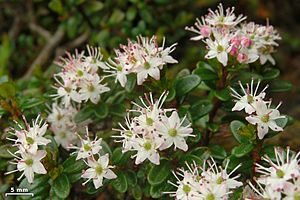Sandmyrtle facts for kids
Quick facts for kids Sandmyrtle |
|
|---|---|
 |
|
| Kalmia buxifolia | |
| Conservation status | |
| Scientific classification | |
| Genus: |
Kalmia
|
| Species: |
buxifolia
|
| Synonyms | |
|
Leiophyllum buxifolium |
|
Kalmia buxifolia, also known as the sandmyrtle, is a cool flowering plant. It belongs to the Ericaceae family, which also includes blueberries and rhododendrons. This plant is special because it grows naturally in only a few separate places in the eastern and southeastern United States.
Contents
Discovering the Sandmyrtle Plant
The sandmyrtle plant is native to the mid-Atlantic and southeastern parts of the United States. It has a "disjunct distribution," which means it grows in three separate areas that are far apart.
These areas include:
- The Pine Barrens in New Jersey.
- The Coastal Plain of North and South Carolina.
- The southeastern Blue Ridge Mountains.
What the Sandmyrtle Looks Like
This plant can look a bit different depending on where it grows. It is a shrub that can be anywhere from 10 centimeters (about 4 inches) to one meter (about 3 feet) tall.
Its leaves can be arranged in two ways on the stems:
- They might be alternate, meaning they grow one after another on opposite sides.
- They might be opposite, meaning they grow in pairs directly across from each other.
The leaves are usually oval or shaped like a spear. They can grow up to 1.4 centimeters (about half an inch) long.
The sandmyrtle's flowers grow in clusters called an inflorescence. These clusters can be a raceme or an umbel. Each cluster can have up to 18 flowers. The petals are usually white or a light pink color. After the flowers, the plant produces a small fruit. This fruit is a capsule, only a few millimeters long.
Where the Sandmyrtle Grows
The sandmyrtle lives in different types of places across its scattered range. In the Carolinas, you might find it growing in sandy plains. In the mountains, it prefers rocky woods. It adapts well to these varied environments.
The Name Buxifolia
The second part of the plant's scientific name, buxifolia, comes from Latin. It means "box-leaved." This refers to plants in the genus Buxus, which are commonly known as boxwood. The sandmyrtle's leaves look similar to those of boxwood plants.
Awards for Gardeners
Both the wild sandmyrtle species and a special type called 'Maryfield' have received an important award. This award is the Royal Horticultural Society's Award of Garden Merit. It means these plants are excellent choices for gardens.


